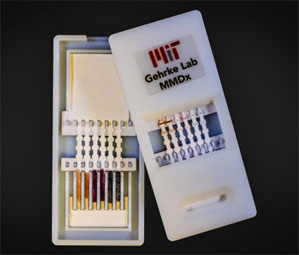A new test from MIT researchers could make it easier to quickly diagnose Ebola, yellow fever, dengue fever, and more, helping health-care workers decide whether a patient needs immediate treatment and isolation.

“As we saw with the recent Ebola outbreak, sometimes people present with symptoms and it’s not clear what they have,” says Kimberly Hamad-Schifferli, a visiting scientist in the Department of Mechanical Engineering and a member of MIT Lincoln Laboratory’s technical staff.
Currently, the only way to diagnose Ebola is to send blood samples to a lab that can perform advanced techniques such as polymerase chain reaction, which can detect genetic material from the Ebola virus. However, many areas of Africa where Ebola and other fevers are endemic have limited access to this technology.
The new device, similar to a pregnancy test, consists of a strip of paper coated at one end with separate stripes of red, orange, and green nanoparticles. Made from silver, the nanoparticles are linked to antibodies recognizing Ebola, dengue fever, and yellow fever, respectively. As blood serum flows along the paper, viral proteins pick up the corresponding antibody-nanoparticle complex and keep moving. Farther along the strip, separate sets of antibodies for each disease grab the viral proteins (and the antibodies and nanoparticles they’ve caught), depositing bands of color for each positive result. This process takes about 10 minutes.
“If you’re in a situation in the field with no power and no special technologies, if you want to know if a patient has Ebola, this test can tell you very quickly that you might not want to put that patient in a waiting room with other people who might not be infected,” says Lee Gehrke, a professor of health sciences and technology in MIT’s Institute for Medical Engineering and Science (IMES), who began working on the new device with Hamad-Schifferli four years ago.
Keep Reading
Most Popular
Large language models can do jaw-dropping things. But nobody knows exactly why.
And that's a problem. Figuring it out is one of the biggest scientific puzzles of our time and a crucial step towards controlling more powerful future models.
The problem with plug-in hybrids? Their drivers.
Plug-in hybrids are often sold as a transition to EVs, but new data from Europe shows we’re still underestimating the emissions they produce.
Google DeepMind’s new generative model makes Super Mario–like games from scratch
Genie learns how to control games by watching hours and hours of video. It could help train next-gen robots too.
How scientists traced a mysterious covid case back to six toilets
When wastewater surveillance turns into a hunt for a single infected individual, the ethics get tricky.
Stay connected
Get the latest updates from
MIT Technology Review
Discover special offers, top stories, upcoming events, and more.